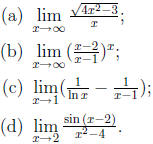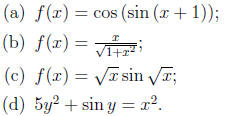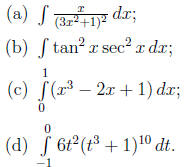1. Find the limits (4 points each)

Solutions
(a) The limit  represents an indeterminate
represents an indeterminate
form  . Therefore we can keep only the leading
terms in the
. Therefore we can keep only the leading
terms in the
numerator and in the denominator of the fraction .
 . Because x tends to positive infinity we
have
. Because x tends to positive infinity we
have
 whence
whence  .
.
(b) The limit  represents an indeterminate
form
represents an indeterminate
form  . As
. As
always when we deal with such an indeterminate form we will first
find the limit of the natural logarithm of our expression . We have
 , and the limit
, and the limit
 is an indeterminate
is an indeterminate
form  because the first factor tends to ∞ and
the second one -
because the first factor tends to ∞ and
the second one -
to ln 1 = 0. To apply the L'Hospital's rule we have to write the last
limit as an indeterminate form  or
or
 . In our case it is easier to write
. In our case it is easier to write
it in the form  , namely,
, namely,
 . According to the
. According to the
L'Hospital's rule we will now differentiate the numerator and the
denominator and look at the following limit (when differentiating the
numerator we combine the chain rule and the quotient rule).

Therefore  .
.
(c) We have here an indeterminate form
 . First we bring it to
. First we bring it to
the form  ,
,
 .
.
Next we use the L'Hospital's rule to obtain the following limit

It is still an indeterminate form
 so we apply the
L'Hospital's rule
so we apply the
L'Hospital's rule
once again and get the limit

(d)

This is an indeterminate form
 and we apply the
L'Hospital's rule.
and we apply the
L'Hospital's rule.

2. Find the derivatives of y = f(x) with respect to x (4
points each)

Solutions.
(a) f(x) = cos (sin (x + 1)). We apply the chain rule to get
f'(x) = -sin (sin (x + 1)) cos (x + 1):
(b) . By the quotient
rule combined with the chain rule
. By the quotient
rule combined with the chain rule
we have

We simplify the last expression by multiplying both
numerator and
denominator by  .
.

(c)  . By the product
rule combined with the chain
. By the product
rule combined with the chain
rule we have

If we recall the formula

then we can also write our answer as

(d) 5y2 + sin y = x2. We apply implicit differentiation to
get

Solving it for  we get
we get

3. Find the integrals (5 points each)

Solutions
(a)

If we notice that x is proportional to the derivative of
3x2 + 1 we can
use the following substitution, u = 3x2 +1. Then
 , du = 6xdx,
, du = 6xdx,
and therefore  . The integral becomes
. The integral becomes

Applying the power rule we get

(b)

Notice that sec2 x equals to the derivative of tan x and
therefore it is
convenient to use the substitution u = tan x. Then du = sec2 xdx and
our integral becomes

(c) We apply the power rule and the Newton - Leibnitz
formula to get

(d)

We use the substitution u = t3 + 1. Then du = 3t2dt whence
6t2dt = 2du. If t = -1 then u = 0, and if t = 0 then u = 1, we will
change the limits of integration accordingly.

4. Use a linear approximation to estimate the following
values (5 points
each)

Solutions In both cases we use the formula for linear
approximation
L(x) = f(a) + f'(a)(x - a)
where point a should satisfy two (informal) conditions
•
a should be close to x
•
the values of f (a) and f0(a) should be easy to compute.
(a) In this case we take  whence
whence
 . We also take
. We also take
a = 64 and x = 63. Then f(a) = 4,  , and x - a
= -1. The
, and x - a
= -1. The
corresponding linear approximation to
 is
is

(b) Remember that we do not use the degree measure in
calculus. In
our case we take

Then

Therefore the value of the linear approximation is




